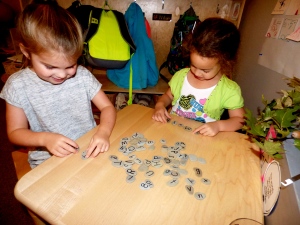This summer I spent a weekend at Presque Isle with my close friend and our four boys. While the boys were burying each other up to their necks in sand, I was sifting through the plethora of smooth stones lying at the water’s edge.
There were so many shapes and sizes, but the generally flat surfaces were the most intriguing aspect. I meticulously gathered a little over 75 small flat stones over the course of the trip. My goal was to create two sets of the alphabet for our class. I found circular ones that would be perfect for lowercase rounded letters. Slightly longer, ovoid rocks would serve for tall, thin lower and upper case letters. The largest stones would be perfect for wide capitals.
My collection lived in one of the many buckets the children had been toting around. (Are you feeling the foreboding?) While I was in the water with one of the boys, the others were back at the blanket, playing with trucks in the sand. Upon returning to our encampment, I found the bucket I had been using emptied and now being used as a chair. The littlest of our tribe had decided that the stones needed to be buried so pirates would not get them.
We spent the next 1/2 hour digging for “treasure”.
In the end, we made it back to Pittsburgh with enough stones for sets of capitals, lower-case letters, and zero to ten numerals.
We recently set our alphabet stones out on a side table to see what might happen. As can be expected, the first words the children tried were familiar and important: their names.
 And yet, we must not forget other important words in their lives. Two boys were about to head out on an adventure with their families. As I was walking by the stone table near lunch this is what I found. One guess where they’re headed.
And yet, we must not forget other important words in their lives. Two boys were about to head out on an adventure with their families. As I was walking by the stone table near lunch this is what I found. One guess where they’re headed.



